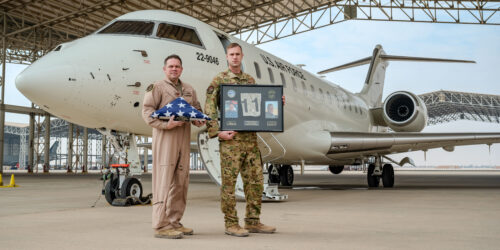To honour the enduring legacy of the two pilots who died in the E-11A crash in Afghanistan five years ago, the U.S. Air Force’s 430th Expeditionary Electronic Combat Squadron (EECS) conducted a combat memorial flight over the U.S. Central Command area of responsibility on Jan. 27, carrying an American flag in tribute.

On Jan. 27, 2020, U.S. Air Force Lt. Col. Paul “Tabs” Voss, 46, and Capt. Ryan “Fogg” Phaneuff, 30, were killed while attempting an emergency landing of their damaged E-11A in the Ghazni province. The E-11A, serving as a vital Battlefield Airborne Communications Node (BACN), provides essential radio connectivity for air and ground forces, particularly in the challenging operational terrain of Afghanistan.
The ill-fated mission was a Mission Qualification Training – 3 (MQT-3) sortie for Phaneuff, whilst simultaneously serving as a combat sortie in support of Operation FREEDOM’S SENTINEL for both pilots. The flight proceeded uneventfully for the first hour and 44 minutes. However, at approximately 1250:52 local time, the left engine suffered a catastrophic failure. A single fan blade separated from the N1 first-stage turbofan, causing significant damage. This event was accompanied by a loud bang, recorded by the Cockpit Voice Recorder (CVR), and severe vibrations, detected by the Digital Flight Data Recorder (DFDR). The Electronic Engine Controller (EEC), a subsystem of the Full Authority Digital Engine Controller (FADEC), automatically shut down the damaged left engine in response to the unreliable signals from the fan’s Revolutions Per Minute (RPM) sensor. This resulted in an amber “L FADEC FAIL” caution message on the Engine Indication and Crew Alerting System (EICAS) display.
In a critical turn of events, the mishap crew (MC) misidentified the failed engine, erroneously shutting down the right engine, which was still fully operational. This decision, made within 24 seconds of the initial failure, led to a dual-engine-out emergency. The crew’s hasty actions, possibly influenced by a startle response to the initial incident, meant there was insufficient time to accurately analyse the situation. Initial throttle movements were too brief to assess engine response effectively. Furthermore, the crew misinterpreted the initial warnings and erratic engine instrument displays; the left engine’s N1 (fan RPM) dropped to 7.6% then spiked to 255.9%, leading them to believe it was unreliable. The shutdown of the right engine produced a white “R ENG SHUTDOWN” message, and a red “DUAL ENGINE OUT” warning appeared approximately 30 seconds later.
Despite attempting to restart the engines, the crew were unsuccessful. With both engines out, the aircraft’s glide capabilities were significantly limited. The crew’s decision to attempt a return to Kandahar Airfield (KAF), approximately 230 nautical miles away, was beyond the aircraft’s glide range. Closer divert options, such as Bagram Airfield (38 NM), Kabul International Airport (17 NM) and FOB Shank (28 NM), were within reach in the minutes following the dual engine failure. Ultimately, the crew attempted to land near Forward Operating Base (FOB) Sharana but crashed approximately 21 NM short of their destination. The Accident Investigation Board (AIB) President concluded that the primary cause of the mishap was the crew’s misdiagnosis of the failed engine, leading to the shutdown of the operable right engine and the failure to airstart the right engine, coupled with the decision to attempt recovery at KAF.
Lt. Col. Randell McCart, the 430th EECS commander, noted that the memorial flight reflected the squadron’s “continued commitment to those who paid the ultimate sacrifice”. He stated that Voss and Phaneuff were integral members of the team who are etched in the squadron’s collective memory and heritage.
In response to the tragedy, the Air Force has introduced several improvements. Inspection criteria have been strengthened to identify potential issues before they escalate. Enhanced training programs now include specialized emergency simulator training that specifically addresses the challenges that led to the mishap. The 430th EECS has also introduced specific squadron standards and procedures to ensure that BACN aviators are better prepared for potential in-flight emergencies. Dual engine out scenarios were not routinely practiced and were considered unlikely prior to the mishap.
The legacy of Voss and Phaneuff endures among their families and the 430th EECS. Many who knew the pilots gathered at Arlington National Cemetery for a memorial service in January. The sacrifice of the crew serves as a constant reminder of the risks aircrews face and the resilience required to carry on their mission. “There isn’t a day that goes by in the 430th EECS where Tabs and Fogg are not remembered and greatly missed,” said McCart.
For more information, hit the Source below